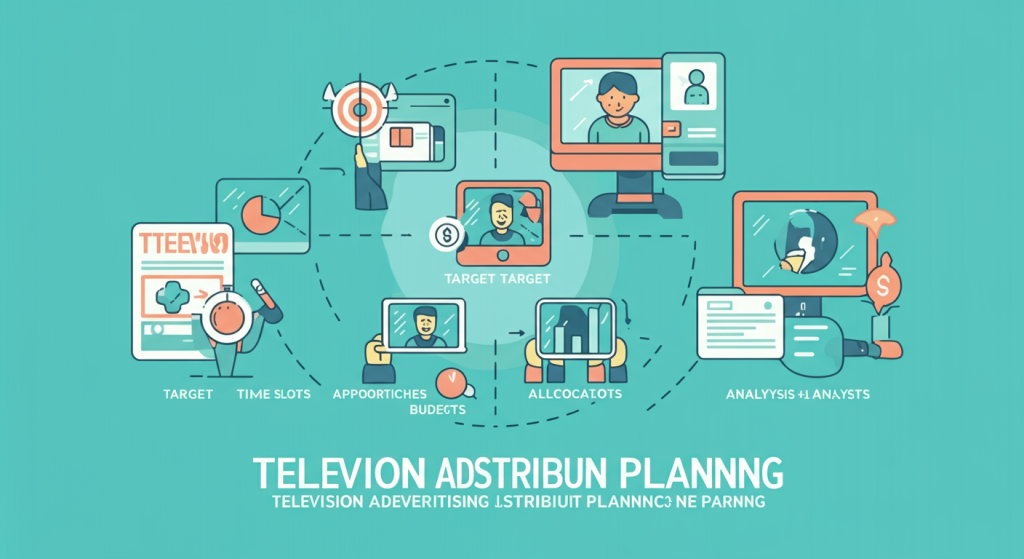Getting your television commercial on the air involves more than just creating great content—it requires navigating a complex distribution system that determines when, where, and how your ads reach audiences. Understanding how television advertising distribution works can help you make smarter media buying decisions and maximize your campaign effectiveness.
This comprehensive guide explains the intricate process of television advertising distribution, from initial planning to final broadcast. You’ll learn about the key players, distribution channels, and strategic considerations that influence how your commercials reach their intended audiences.
The Television Advertising Distribution Ecosystem
Television advertising distribution operates through a sophisticated network of broadcasters, cable operators, streaming platforms, and intermediaries. Each component plays a crucial role in delivering your commercial message to target audiences across different viewing platforms and geographic regions.
Broadcast Networks and Local Stations
Broadcast networks like ABC, CBS, NBC, and FOX form the foundation of television advertising distribution. These networks create programming schedules and sell advertising inventory to national advertisers, while local affiliate stations handle regional and local advertising opportunities.
Local stations receive network programming but also produce their own content, creating additional advertising inventory for businesses targeting specific geographic markets. This dual-level structure allows advertisers to choose between national reach and local precision.
Cable and Satellite Operators
Cable and satellite providers distribute hundreds of channels to subscribers, creating vast advertising inventory across specialized programming. These operators manage both national cable networks and local advertising insertion opportunities.
Cable operators can insert local commercials into national programming streams, allowing businesses to advertise on popular national shows while targeting specific local markets. This capability makes cable advertising particularly attractive for regional businesses.
Streaming and Connected TV Platforms
Streaming services and connected TV platforms represent the fastest-growing segment of television advertising distribution. These platforms deliver content through internet connections, enabling more precise targeting and measurement capabilities.
Unlike traditional broadcast distribution, streaming platforms can serve different advertisements to different viewers watching the same program, creating personalized advertising experiences based on viewer data and preferences.
How Television Advertising Distribution Planning Works
Effective television advertising distribution begins with comprehensive planning that considers audience behavior, viewing patterns, and campaign objectives. This planning phase determines how your commercials will reach target audiences across different distribution channels.

Audience Research and Targeting
Television advertising distribution starts with detailed audience research to understand when and where your target customers consume media. This research influences decisions about which networks, time slots, and distribution channels will most effectively reach your desired audience.
Media planners analyze demographic data, viewing habits, and program preferences to identify optimal distribution strategies. This analysis helps determine whether national network advertising, local broadcast placement, or cable distribution will best serve your campaign goals.
Geographic Distribution Strategy
Television advertising distribution varies significantly by geographic region, with different networks and stations serving different markets. Advertisers must decide whether to pursue national distribution, focus on specific regions, or target individual local markets.
National distribution provides broad reach but may waste impressions in irrelevant markets. Regional distribution allows more focused targeting while maintaining significant scale. Local distribution offers precise geographic targeting but limits total reach potential.
Daypart and Programming Selection
Television advertising distribution depends heavily on programming schedules and daypart availability. Different programs and time slots attract different audiences, requiring strategic selection based on your target demographic and campaign objectives.
Prime time programming offers maximum reach but commands premium prices and faces intense competition for available inventory. Daytime and late-night distribution provide more affordable options while reaching specific audience segments.
Morning programming attracts viewers starting their day, while afternoon slots often reach stay-at-home audiences. Weekend distribution patterns differ significantly from weekday schedules, requiring separate strategic consideration.
The Media Buying and Distribution Process
Television advertising distribution involves multiple steps and stakeholders who coordinate to ensure your commercials reach intended audiences at optimal times and frequencies.
Media Planning and Strategy Development
Media planners develop comprehensive distribution strategies that align with campaign objectives and budget constraints. This planning considers audience behavior, competitive activity, and seasonal viewing patterns to optimize commercial placement.
The planning process involves analyzing historical performance data, audience research, and market conditions to identify the most effective distribution mix. Planners must balance reach, frequency, and cost considerations while ensuring adequate coverage across target markets.
Inventory Purchase and Negotiation
Television advertising distribution requires purchasing specific time slots or inventory packages from various media outlets. This process involves negotiating rates, securing preferred placement, and coordinating technical requirements across multiple distribution channels.
Media buyers negotiate with network representatives, local stations, and cable operators to secure optimal placement at competitive rates. These negotiations consider factors like audience delivery, programming environment, and scheduling flexibility.
Distribution Coordination and Trafficking
Once inventory is purchased, the distribution process requires coordinating commercial delivery and placement across multiple outlets. This trafficking process ensures your commercials reach the right stations at the right times with proper technical specifications.
Distribution coordinators work with broadcast traffic departments to schedule commercial placement, verify technical requirements, and confirm delivery instructions. This coordination prevents missed opportunities and ensures consistent message delivery.
Technical Aspects of Television Advertising Distribution
Television advertising distribution involves complex technical requirements that ensure your commercials broadcast properly across different platforms and viewing environments.
Commercial Specifications and Standards
Television advertising distribution requires adherence to specific technical standards for video quality, audio levels, and file formats. These standards ensure consistent playback across different broadcast systems and viewing devices.
Broadcast standards specify requirements for video resolution, frame rates, color spaces, and audio characteristics. Cable and streaming platforms may have additional requirements for digital delivery and playback optimization.
Satellite and Fiber Distribution Networks
Television advertising distribution relies on satellite and fiber networks to deliver programming and commercials to local stations and cable systems. These networks provide the infrastructure that enables simultaneous distribution across multiple markets.
Satellite distribution allows real-time delivery of commercials to stations nationwide, while fiber networks provide high-capacity connections for digital content delivery. These systems enable efficient distribution while maintaining technical quality standards.
Local Insertion and Automation Systems
Local television advertising distribution utilizes automated systems that insert commercials into programming streams at predetermined times. These systems coordinate with network feeds to seamlessly integrate local advertising with national programming.
Automation systems manage complex scheduling requirements, ensuring commercials play at correct times while maintaining programming continuity. These systems also generate verification reports that confirm successful distribution and playback.
Digital and Streaming Distribution Channels
Modern television advertising distribution increasingly includes digital and streaming platforms that offer new targeting capabilities and measurement opportunities.

Connected TV and OTT Platforms
Connected TV and over-the-top (OTT) platforms distribute television content through internet connections, enabling more sophisticated advertising distribution strategies. These platforms can serve different advertisements to different viewers based on demographic and behavioral data.
OTT distribution allows advertisers to reach cord-cutting audiences while maintaining television-like viewing experiences. These platforms often provide more detailed performance metrics and targeting options compared to traditional broadcast distribution.
Programmatic TV Advertising Distribution
Programmatic technology automates television advertising distribution by using data and algorithms to optimize commercial placement in real-time. This technology enables more efficient inventory purchasing and audience targeting across multiple distribution channels.
Programmatic distribution can automatically adjust commercial placement based on audience behavior, inventory availability, and campaign performance. This automation improves efficiency while reducing manual coordination requirements.
Cross-Platform Distribution Integration
Modern television advertising distribution often integrates multiple platforms and channels to create comprehensive audience coverage. This integration requires coordinating campaigns across broadcast, cable, streaming, and digital platforms.
Cross-platform distribution enables advertisers to reach audiences across different viewing environments while maintaining consistent messaging and branding. This approach maximizes reach while accommodating changing viewing habits.
Measuring Television Advertising Distribution Success
Effective television advertising distribution requires ongoing measurement and optimization to ensure campaigns achieve intended objectives and reach target audiences efficiently.
Audience Measurement and Verification
Television advertising distribution success depends on accurate audience measurement that confirms commercial delivery and viewership. Traditional ratings systems provide demographic breakdowns and reach estimates for broadcast and cable distribution.
Streaming platforms offer more detailed measurement capabilities, including individual viewer tracking and engagement metrics. These measurements help verify that distribution strategies effectively reach intended audiences.
Geographic and Demographic Analysis
Television advertising distribution measurement analyzes performance across different geographic markets and demographic segments. This analysis helps identify successful distribution strategies and areas needing optimization.
Market-by-market analysis reveals which distribution channels and time slots perform best in different regions. Demographic analysis shows how effectively campaigns reach target audience segments across various distribution platforms.
Attribution and Performance Tracking
Television advertising distribution measurement increasingly focuses on attribution modeling that connects advertising exposure to business outcomes. This tracking helps justify distribution investments and optimize future campaigns.
Advanced measurement systems can track viewer behavior across multiple touchpoints, providing insights into how television advertising distribution contributes to overall marketing effectiveness.
Optimizing Your Television Advertising Distribution Strategy
Successful television advertising distribution requires ongoing optimization based on performance data, market changes, and evolving audience behavior patterns.

Seasonal and Cyclical Adjustments
Television advertising distribution strategies must adapt to seasonal viewing patterns and cyclical audience behavior. Holiday seasons, sports schedules, and local events significantly impact optimal distribution timing and channel selection.
Summer viewing patterns differ substantially from winter habits, requiring distribution adjustments to maintain audience reach. Back-to-school periods and major sporting events create opportunities for targeted distribution strategies.
Competitive Intelligence and Market Analysis
Effective television advertising distribution considers competitive activity and market conditions that influence audience availability and inventory costs. This intelligence helps identify opportunities and avoid oversaturated time periods.
Competitive analysis reveals which distribution channels and time slots competitors prioritize, providing insights for strategic positioning. Market analysis identifies emerging opportunities and potential challenges for distribution planning.
Budget Optimization and Efficiency
Television advertising distribution requires balancing reach, frequency, and cost considerations to maximize campaign effectiveness within budget constraints. This optimization involves continuous evaluation of distribution channel performance and cost efficiency.
Regular performance analysis helps identify underperforming distribution channels and redirect spending toward more effective opportunities. This ongoing optimization ensures maximum return on advertising investment.
Maximizing Your Television Advertising Distribution Impact
Understanding how television advertising distribution works empowers you to make informed decisions about media strategy, budget allocation, and campaign optimization. The distribution landscape continues evolving with new technologies and viewing habits, requiring adaptable strategies and ongoing learning.
Success in television advertising distribution depends on comprehensive planning, technical expertise, and continuous optimization based on performance data. Consider working with experienced media professionals who understand the complexities of modern distribution systems and can navigate changing market conditions.
Start by clearly defining your target audience and distribution objectives. Research available channels and platforms that align with your audience’s viewing habits and your campaign goals. Don’t overlook emerging opportunities in connected TV and streaming platforms that offer new targeting capabilities.
Remember that effective television advertising distribution requires sustained investment and patience. The most successful campaigns integrate multiple distribution channels while maintaining consistent messaging and strategic focus. By understanding these distribution fundamentals, you can develop more effective television advertising campaigns that reach the right audiences at the right times.
In addition to understanding how TV ads are distributed across networks and regions, it’s helpful to explore how event marketing strategies can complement broadcast campaigns by offering direct, in-person brand engagement opportunities.





